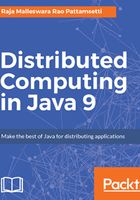
Parallel versus distributed computing
While both distributed computing and parallel systems are widely available these days, the main difference between these two is that a parallel computing system consists of multiple processors that communicate with each other using a shared memory, whereas a distributed computing system contains multiple processors connected by a communication network.

In parallel computing systems, as the number of processors increases, with enough parallelism available in applications, such systems easily beat sequential systems in performance through the shared memory. In such systems, the processors can also contain their own locally allocated memory, which is not available to any other processors.
In distributed computing systems, multiple system processors can communicate with each other using messages that are sent over the network. Such systems are increasingly available these days because of the availability at low price of computer processors and the high-bandwidth links to connect them.
The following reasons explain why a system should be built distributed, not just parallel:
- Scalability: As distributed systems do not have the problems associated with shared memory, with the increased number of processors, they are obviously regarded as more scalable than parallel systems.
- Reliability: The impact of the failure of any single subsystem or a computer on the network of computers defines the reliability of such a connected system. Definitely, distributed systems demonstrate a better aspect in this area compared to the parallel systems.
- Data sharing: Data sharing provided by distributed systems is similar to the data sharing provided by distributed databases. Thus, multiple organizations can have distributed systems with the integrated applications for data exchange.
- Resources sharing: If there exists an expensive and a special purpose resource or a processor, which cannot be dedicated to each processor in the system, such a resource can be easily shared across distributed systems.
- Heterogeneity and modularity: A system should be flexible enough to accept a new heterogeneous processor to be added into it and one of the processors to be replaced or removed from the system without affecting the overall system processing capability. Distributed systems are observed to be more flexible in this respect.
- Geographic construction: The geographic placement of different subsystems of an application may be inherently placed as distributed. Local processing may be forced by the low communication bandwidth more specifically within a wireless network.
- Economic: With the evolution of modern computers, high-bandwidth networks and workstations are available at low cost, which also favors distributed computing for economic reasons.